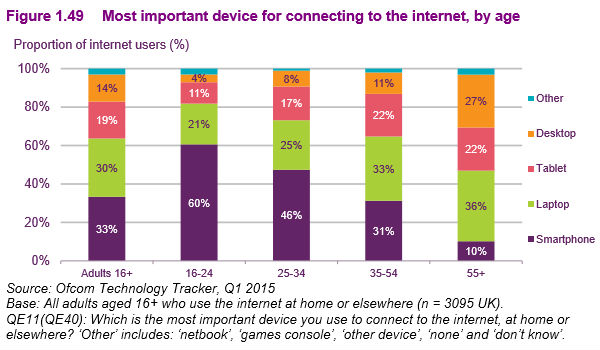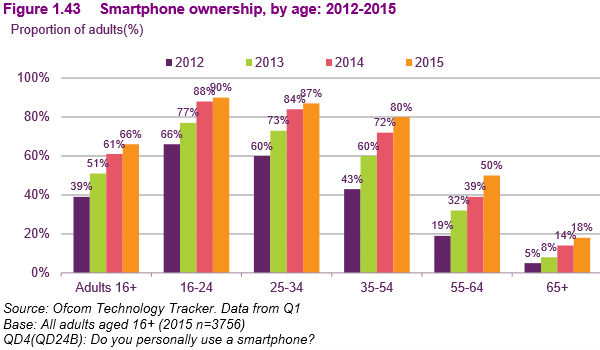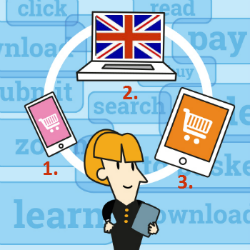Did you miss it?
Walking around any place in the UK it is hard not to see someone looking at their smartphone, therefore it is not surprising that the UK’s Ofcom(1) report out in August 2015 heralding in the official status that the UK is a “Smartphone society” went largely unnoticed. So if you missed it (buried in the depths of a 435 page report) here it is… “For the first time, the smartphone has overtaken the laptop as the device internet users say is the most important for connecting to the internet; in 2015 33% chose their smartphone…” and there is even a funky graph to go with it.
 Down into the details of smartphone for business marketing
Down into the details of smartphone for business marketing
Once you overlay preferred device for connecting to the internet with the percentage of smartphone owners by age... thanks to Ofcom for another funky graph (see below)... then you begin to get a 3D picture of how your potential audience can be marketed to. If you are trying to market to the 16-24 year old and you don’t have your mobile marketing strategy sorted out then you need to do so as soon as possible. Even the 25-34 year old group is highly smartphone oriented.
If you are trying to target the more senior management in the 35-55 years old range then there is a stronger showing on tablet computers then for other age groups but for them their laptop is the most important way they connect to the internet.

Not all smartphones are the same
To add another dimension to the smartphone equations you will see from the final graph I include from Ofcom that the iPhone and Samsung are neck-and-neck with 34% of the market share. This probably does not matter much to you unless, like me, you are trying to improve your click through rates on HTML emails read on mobile devices (see last month’s blog). The way HTML emails look and behave – even with a responsive email template – is different on the two devices. More on that in our next blog!

What else can we assume from these Ofcom stats on smartphones?
While there are certainly country specific differences in the use of smartphones in the different major European countries and in the USA, the general trend is still obvious and here to stay. Smartphones are the way most of us chose to connect to the internet. As business development and marketing professionals we need to recognize this and realign our strategies to embrace it.
From the Ofcom report I picked the points that interested me the most. If you would like to read the full UK Ofcom “Communications Market Report 2015”, all 435 pages of it, you can download here.
Below is a summary of the main findings relating to smartphones. I have also included a section about 4G users as there are some interesting points relating to 4G user habits for video usage on smartphones and mobile shopping.
A smartphone society
 • Two-thirds of adults have a smartphone. 93% of UK adults said they had a mobile phone in the first quarter of 2015. Of these, 71% said they had a smartphone; 66% of the adult population. This has increased by 27 percentage points since 2012.
• Two-thirds of adults have a smartphone. 93% of UK adults said they had a mobile phone in the first quarter of 2015. Of these, 71% said they had a smartphone; 66% of the adult population. This has increased by 27 percentage points since 2012.
• Young people are ten times as likely as older people to say their mobile phone is the device they would miss the most. Three in five (59%) 16-24 year olds named their mobile phone as the device they would miss the most if it were taken away, compared to less than a fifth (17%) who cited a TV set. In comparison, just 6% of those aged 55 and over said they would miss their phone the most, while 57% of this age group said they would most miss the TV set.
• For the first time, the smartphone has overtaken the laptop as the device internet users say is the most important for connecting to the internet; in 2015 33% chose their smartphone, and 30% chose their laptop, compared with 23% and 40% respectively in 2014. Furthermore, smartphones are now the most widely owned internet-enabled device (66%), on a par with laptops (65% of households).
• Half of smartphone users say they are ‘hooked’ on their mobile phone. About half of smartphone users (48%) score themselves at 7 or above when asked to describe how hooked they are on their mobile phone on a scale of 1-10, rising to three-fifths (61%) of young people aged 16-24.
• Half of young people aged 18-24 check their phones within five minutes of waking and two-fifths check it less than five minutes before going to sleep. Three in ten adults (29%) said they checked their phones within five minutes of waking up, increasing to about half of 18-24 year olds (48%). The first thing people are most likely to access is text messages (35% of adults, 38% of 18-24 year olds).
• Despite its multiple uses, the smartphone remains primarily a communications device. Almost three-quarters (72%) of the time spent on a smartphone is on communications activities, including text messages, email, using social networks, instant messages and calls (voice or video).
• While emailing is the most popular form of communications undertaken on a smartphone (81% of users), photo and video based forms of communication are used by some smartphone owners. Just over four in ten (42%) smartphone users send photos or videos via text, while 18% use their phone for video internet calls.
• Smartphones are twice as likely to be used for watching short video clips than for full-length programmes. Although a smartphone can allow users to access any online film or television service, users are twice as likely to use their phones to watch short-form video clips than for streaming television programmes or films (42% vs. 21%).
• A substantial proportion of smartphone owners use their phones for transactional activities, including making purchases online (45%) and online banking (44%).
• A fifth of smartphone users admit to having used their phones in a cinema or theatre. About three-fifths of smartphone users think it is unacceptable to use a mobile in cinemas or theatres (60%) or in restaurants with others (59%). Despite this, 45% of smartphone users admit to having used their device in a restaurant and a fifth (22%) admit to having used it when in a cinema or theatre.
• One in four mobile phone users have donated to charity by text message. A quarter (25%) of mobile phone users have texted a donation to charity. This is more likely to be done by those aged 25-54 (30%) than by older users (15%).
With reference to 4G users:
• Nearly a third (30%) of UK adults say they now have access to 4G. 4G stands for 4th generation, and relates to the 4th generation mobile communications standard, which allows internet access at higher speeds than previous standards. This equates to 45% of UK smartphone users, an increase of 28 percentage points since 2014.
• 4G users show significantly different online behaviour compared to smartphone owners without 4G access. 4G users are more likely to go online more often, be more attached to their smartphones, do more ‘data-heavy’ activities online and do them more often.
• 4G users are more likely than smartphone owners without 4G access to use mobile internet outside the home. 55% of smartphone users without 4G say they use WiFi to go online when they are away from home. However, this drops to 47% of 4G users, who are more likely to use their mobile network to go online (87% vs. 69% of those without access).
• 4G users are more likely to use their smartphones to access audio-visual content. 57% of 4G users access audio-visual content on their smartphones compared to 40% of those without 4G access. There is a similar difference when considering audio activities with 47% of 4G users accessing this type of content on their smartphone, compared to 28% of those without 4G access.
• Over half of 4G users use their smartphone to make online purchases or use online banking, compared to a third of those without 4G access. 4G users are more likely to use their smartphones for doing online banking (55% vs. 33% of those without 4G) and making online purchases (55% vs. 35%).
• More than a quarter of 4G users say they access audio-visual content more often now that they have access to 4G. The activity that 4G users are most likely to say they are doing more of, since they have had access to this network, is viewing /downloading audio-visual content, with 28% saying they do this more. A quarter (24%) also say they make internet calls more, and also do more general web browsing since having access to the 4G network.
(1) the Independent regulator and competition authority for the UK communications industries
Find out more country specific statistics on m-commerce in Europe in our ebook E-commerce in Europe!

